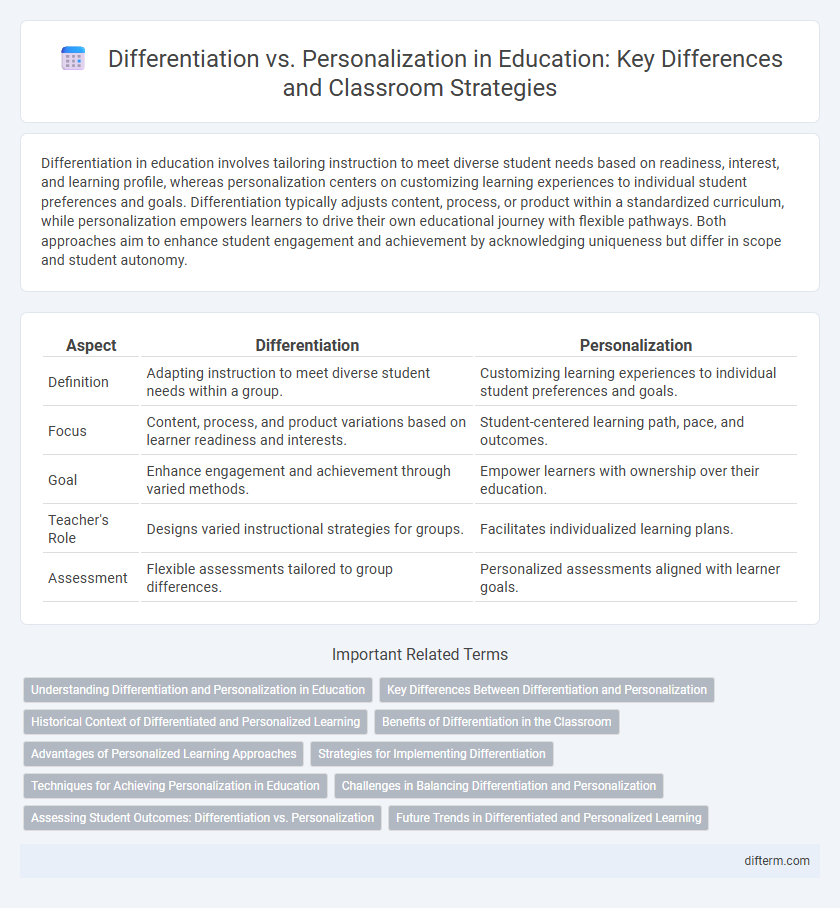Differentiation in education involves tailoring instruction to meet diverse student needs based on readiness, interest, and learning profile, whereas personalization centers on customizing learning experiences to individual student preferences and goals. Differentiation typically adjusts content, process, or product within a standardized curriculum, while personalization empowers learners to drive their own educational journey with flexible pathways. Both approaches aim to enhance student engagement and achievement by acknowledging uniqueness but differ in scope and student autonomy.
Table of Comparison
| Aspect | Differentiation | Personalization |
|---|---|---|
| Definition | Adapting instruction to meet diverse student needs within a group. | Customizing learning experiences to individual student preferences and goals. |
| Focus | Content, process, and product variations based on learner readiness and interests. | Student-centered learning path, pace, and outcomes. |
| Goal | Enhance engagement and achievement through varied methods. | Empower learners with ownership over their education. |
| Teacher's Role | Designs varied instructional strategies for groups. | Facilitates individualized learning plans. |
| Assessment | Flexible assessments tailored to group differences. | Personalized assessments aligned with learner goals. |
Understanding Differentiation and Personalization in Education
Understanding differentiation and personalization in education involves recognizing how each approach addresses diverse student needs to enhance learning outcomes. Differentiation tailors instruction by adapting content, process, or product based on students' readiness, interests, and learning profiles, while personalization customizes the entire learning experience to individual student goals, preferences, and pace. Both strategies aim to create inclusive learning environments, but personalization emphasizes student autonomy and continuous feedback to foster deeper engagement and mastery.
Key Differences Between Differentiation and Personalization
Differentiation tailors instruction to meet varied student readiness levels, interests, and learning profiles within a group, whereas personalization customizes the learning experience based on an individual student's strengths, needs, and pace. Differentiation uses flexible grouping, varied materials, and assessment methods, while personalization often involves learner-driven goals and adaptive technology. Both approaches aim to improve student engagement and achievement but differ in scope and implementation strategies.
Historical Context of Differentiated and Personalized Learning
Differentiated learning emerged in the 1960s as educators sought strategies to address diverse student abilities within a single classroom, emphasizing tailored instruction based on readiness, interests, and learning profiles. Personalized learning evolved more recently, gaining momentum in the 2000s with advancements in technology, focusing on learner autonomy and customization of educational experiences to individual goals and pace. Both approaches reflect shifts from uniform instruction toward more adaptive teaching methods aligned with research on student engagement and cognitive development.
Benefits of Differentiation in the Classroom
Differentiation in the classroom enhances student engagement by tailoring instruction to diverse learning styles, readiness levels, and interests, promoting deeper understanding and retention of material. It supports inclusive education by addressing individual needs without isolating any student, fostering a collaborative and supportive learning environment. Data-driven differentiation improves academic outcomes by providing targeted challenges and scaffolding, enabling all students to achieve their potential.
Advantages of Personalized Learning Approaches
Personalized learning approaches enhance student engagement by tailoring instruction to individual learning styles, paces, and interests. This method fosters deeper comprehension and higher retention rates by addressing unique learner needs, unlike one-size-fits-all models. Data-driven insights enable educators to adapt content dynamically, promoting academic growth and self-directed learning skills.
Strategies for Implementing Differentiation
Strategies for implementing differentiation in education include varying instructional methods based on student readiness, interests, and learning profiles to enhance engagement and mastery. Teachers can utilize flexible grouping, tiered assignments, and ongoing assessment data to tailor content, process, and product effectively. Incorporating technology tools enables real-time adjustments and personalized learning pathways that support diverse learner needs within a differentiated classroom environment.
Techniques for Achieving Personalization in Education
Techniques for achieving personalization in education include adaptive learning technologies that tailor content to individual student needs, and formative assessments that provide real-time feedback for customizing instruction. Project-based learning allows students to explore topics aligned with their interests and strengths, fostering deeper engagement. Flexible learning environments, such as choice boards and learning contracts, empower students to take ownership of their educational paths while educators monitor progress and adjust support accordingly.
Challenges in Balancing Differentiation and Personalization
Balancing differentiation and personalization in education presents challenges such as managing diverse learning needs while maintaining curriculum standards and teacher workload. Differentiation requires adjusting content delivery for groups, whereas personalization focuses on tailoring learning experiences to individual student interests and pace, which can demand significant time and resource allocation. Effective implementation calls for strategic planning and professional development to optimize instructional approaches and technology integration.
Assessing Student Outcomes: Differentiation vs. Personalization
Assessing student outcomes in differentiation involves measuring progress based on varied instructional strategies tailored to diverse learning needs within the same content framework. Personalization assessment, however, emphasizes individual learner goals, preferences, and pace, often utilizing adaptive technologies and self-reflection tools to gauge mastery. Both approaches require distinct evaluation metrics to effectively capture the impact on student engagement, growth, and achievement.
Future Trends in Differentiated and Personalized Learning
Future trends in differentiated and personalized learning emphasize the integration of AI-driven analytics to tailor instructional strategies according to individual student performance and learning styles. Adaptive learning technologies will enable real-time content adjustments, enhancing engagement and effectiveness across diverse classrooms. Data interoperability and privacy frameworks are increasingly prioritized to support scalable, customized educational experiences while safeguarding student information.
Differentiation vs Personalization Infographic

 difterm.com
difterm.com